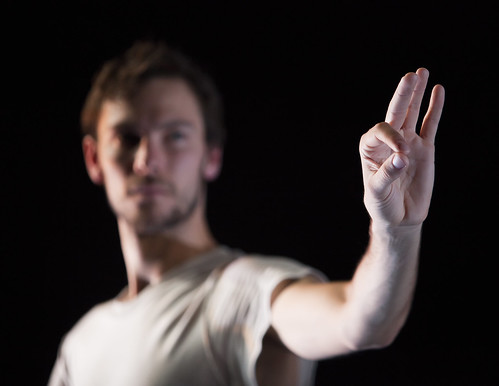Review – Within This Dust
* * * *
Traverse Theatre
Guest Reviewer: Irene Brown
9/11 – two numbers that have become a universal shorthand for disaster, shock and human tragedy. Two numbers that come to mind as Scottish dance company, smallpetitklein, perform their acclaimed two act piece Within This Dust as part of the Traverse’s five day Autumn Dance Festival.
The piece is inspired by a series of photographs by Richard Drew which include the dramatic and poignant image of a man falling from the World Trade Center in New York during the attacks on September 11 2001.
That particular controversial and emotive image of a human being, dressed for a day at the office, jumping from the doomed building inspired the 18 minute section, Falling Man. Previously it has been staged as a stand-alone piece but is now incorporated into Within this Dust.
Sounds of a trundling ghost train going through a tunnel fil the auditorium as the audience take their seats. The noise makes the ensuing pre-show silence even more deafening. The wide stage is filled with a crinoline of crumpled paper with dancer Marta Masiero cradling a bundle of it close to her chest. In Embers she slowly moves among this shape-changing mass to the powerful music of Max Richter and Olafur Arnolds.
There is more movement than dance in these first two parts, as she shifts to the shortest section, Absence of Options. Masiero displays actions of seeking and finding before gaining an uneasy sleep among these embers. Sounds of metallic eerie birdsong add to the atmosphere of loss. She manipulates the paper – at times deliberately like puppetry and at others imaginatively. as when seven sheets become her bed. All the while, the dust is present.
Supple grace
As the real dust settles on stage after the slow sweeping of an aftermath clean up, dancer Tom Pritchard joins Masiero for S/He. To music by Gorecki, the two move with supple grace as they mirror each other in falling and collapsing movements, lovers together against the odds, against the world. An engaging piece of dance.
Graeme Hawkins (aka Retchy)’s ten minute animation 11 is shot in black and white. The screen images move like the slats of a plastic curtain, then have an underwater effect like looking at a fish tank that morphs to a flock of birds. A voice describes the types of lethal cement, glass and asbestos dust that formed the residue of the attack and whose presence in the bodies of survivors means ‘It hasn’t stopped’.
The final and longest work, Falling Man, is performed by Tom Pritchard with music by Max Richter. The dance is performed amidst smoke and is accompanied by narration done by Pritchard and based on an article by Tom Junod. Beautifully choreographed, this piece is a testament not just to the one victim who became known as The Falling Man because he was caught on camera in such an apparently relaxed pose with his humanizing ‘high tops’, but to the 200 other ‘jumpers’.
Talking and dancing seem uneasy bedfellows and the narration in Falling Man felt like a shouting harangue that distracted from the otherwise fine performance. It felt like too much telling and not enough showing. The music and sound effects were amazing but over-amplified.
Marking ten years since the attack, Tom Leonard wrote an article on 11 September 2011 exposing the complexities of the concept of jumping in some groups where it is viewed as suicide. In these groups, identifying the person whose tiny final image was caught by Richard Drew is a problem, which is why these people may have been ‘airbrushed from history’. Within This Dust is an important reminder that the Falling Man was ‘somebody’s husband, somebody’s son’.
Run ended
smallpetitklein website: www.smallpetitklein.com
ENDS



















